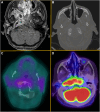Central Skull Base Osteomyelitis in Queensland, Australia, 2010-2020
- PMID: 39450399
- PMCID: PMC11500440
- DOI: 10.1093/ofid/ofae614
Central Skull Base Osteomyelitis in Queensland, Australia, 2010-2020
Abstract
Background: Central skull base osteomyelitis (CSBO) is an incompletely defined, life-threatening infection of the bones of the cranial vault. We describe the clinical features and outcomes of CSBO in Queensland, Australia, over an 11-year period.
Methods: Medical record coding enquiries identified cases of CSBO across 6 tertiary hospitals in Queensland, Australia, from January 2010 to December 2020. Epidemiological, demographic, diagnostic, management, and outcome data were collected from each identified case.
Results: Twenty-two cases of CSBO were identified within the study period; the median age was 73 years with a male predominance (73%). High rates of comorbid disease were detected, with a median Charlson Comorbidity Index score of 5. Diabetes mellitus was the most frequently observed condition. Six cases had bone sampling for microbiological diagnosis while the remainder had superficial sampling of contiguous structures. The most common pathogen isolated was Pseudomonas aeruginosa followed by Staphylococcus aureus, with only 1 case of fungal infection. This series demonstrated a mortality rate of 31.8%, with 45.5% of cases left with long-term sequelae including persistent pain and cranial nerve deficits.
Conclusions: Four key observations emerged in this series: (1) advanced age and diabetes mellitus are common risk factors for CSBO, (2) limited surgical intervention occurred, (3) microbiological diagnoses relied primarily on superficial sampling, and (4) significant mortality and morbidity was observed. Prospective studies are needed to better understand the optimal approach to the diagnosis and management of CSBO and to improve clinical outcomes.
Keywords: Australia; bacterial infection; fungal infection; osteomyelitis; skull base.
© The Author(s) 2024. Published by Oxford University Press on behalf of Infectious Diseases Society of America.
Figures



References
-
- Takahashi T, Takahashi K, Horii A. Skull base osteomyelitis: a rare but life-threatening illness. Lancet Infect Dis 2022; 22:1398. - PubMed
LinkOut - more resources
Full Text Sources

